


RICHARD WAGNER 1813 - 1883
(G3c, G4, W4, Va, Vb, Vc)
Acknowledgements
Wagner: engraving by the German artist Robert Reyher (1838-1877), after a painting by the German artist Franz von Lenbach (1836-1904) – Haags Gemeentemuseum, The Hague, The Netherlands. Siegfried: by the English illustrator Arthur Rackham (1867-1939), 1911, contained in Siegfried and the Twilight of the Gods by Richard Wagner. Hitler: date and artist unknown. Gondola: artist unknown. Nietzsche: photograph by a Mr F. Hartmann, Basel, c1875. Bruckner: by the Austrian painter Josef Buche (1848-1917). St. Florian: etching by the Austrian artist Joseph Eidenberger (1899-1991). Humperdinck: date and photographer unknown.
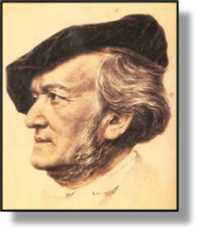 xxxxxAs we have seen, it was in 1845 (Va) that the German composer Richard Wagner produced his opera Tannhauser. This, together with his earlier work The Flying Dutchman (1843) and his later work Lohengrin (1850), had little success. His novel idea that opera should be a total blend of all its components - music, drama, poetry and scenic design - was condemned for breaking away from the traditional form. Then In 1849, having taken part in the uprising in Dresden the previous year, he was forced to take refuge in Zurich and it was here that, undaunted, he began working on his The Ring of the Nibelung, a monumental work made up of four operas which would take him over 25 years to complete. In 1861 he was able to return to Germany, but with his work still out of favour and obliged to live off the generosity of others, it seemed that his career had come to an end, along with his declared aim to provide the musical world with “The Art Work of the Future”.
xxxxxAs we have seen, it was in 1845 (Va) that the German composer Richard Wagner produced his opera Tannhauser. This, together with his earlier work The Flying Dutchman (1843) and his later work Lohengrin (1850), had little success. His novel idea that opera should be a total blend of all its components - music, drama, poetry and scenic design - was condemned for breaking away from the traditional form. Then In 1849, having taken part in the uprising in Dresden the previous year, he was forced to take refuge in Zurich and it was here that, undaunted, he began working on his The Ring of the Nibelung, a monumental work made up of four operas which would take him over 25 years to complete. In 1861 he was able to return to Germany, but with his work still out of favour and obliged to live off the generosity of others, it seemed that his career had come to an end, along with his declared aim to provide the musical world with “The Art Work of the Future”.
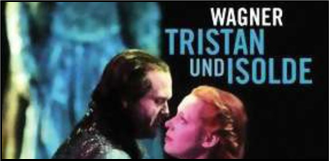 xxxxxBut in 1864 fate took a hand and made possible the fulfilment of his destiny. In that year the young Ludwig II came to the throne of Bavaria. A fanatical devotee of Wagner, he invited him to Munich, paid off his debts, provided him with a villa and a generous allowance, and put the city’s opera house at his disposal. At last, living in the comfort for which he yearned, he was able to let the world hear and enjoy his revolutionary works. Tristan and Isolde was given its premier the next year, a passionate story of forbidden love, inspired at the time of its composition (the late 1850s) by his own unfulfilled dreams of love for Mathilde Wesendonck, the wife of one of his patrons. In this work he was influenced by the writings of the German philosopher Arthur Schopenauer. In accordance with his contention that music was more important than the word, he gave the orchestra the predominant role in the drama, filling the stage with a rich outpouring of sound and passion, rapture and gloom. In fact it took some time for the opera to be widely performed, mainly because of its length, unfamiliar style, and the difficulty of finding singers capable of coping with the two major roles.
xxxxxBut in 1864 fate took a hand and made possible the fulfilment of his destiny. In that year the young Ludwig II came to the throne of Bavaria. A fanatical devotee of Wagner, he invited him to Munich, paid off his debts, provided him with a villa and a generous allowance, and put the city’s opera house at his disposal. At last, living in the comfort for which he yearned, he was able to let the world hear and enjoy his revolutionary works. Tristan and Isolde was given its premier the next year, a passionate story of forbidden love, inspired at the time of its composition (the late 1850s) by his own unfulfilled dreams of love for Mathilde Wesendonck, the wife of one of his patrons. In this work he was influenced by the writings of the German philosopher Arthur Schopenauer. In accordance with his contention that music was more important than the word, he gave the orchestra the predominant role in the drama, filling the stage with a rich outpouring of sound and passion, rapture and gloom. In fact it took some time for the opera to be widely performed, mainly because of its length, unfamiliar style, and the difficulty of finding singers capable of coping with the two major roles.
xxxxxIn December 1865 he was forced to leave Munich - largely due to his extravagance, arrogance and lack of morals - but Ludwig continued his support and set him up in a sumptuous villa at Tribschen beside Lake Lucerne. There, in the company of his current mistress Cosima (the wife of his favourite conductor Hans von Bulow and daughter of Franz Liszt), he worked on The Mastersingers of Nuremberg, his one comic opera. Set in the 16th century, this was in quite a different vein from his earlier works. The music flowed, the atmosphere was good humoured, and, to make it so, he was prepared to retain certain elements of traditional opera. The work was performed at Munich in 1868 and was well received.
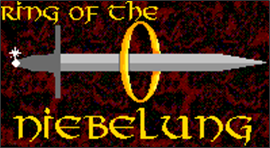 xxxxxBut still to come was his masterpiece The Ring of the Nibelung, a sequence of four operas based on Teutonic myth and legend, and having as its theme - as in most of his work - the concept of “redemption through love”. For this monumental work Wagner considered the Munich Opera House inadequate, so in 1870 he set about raising funds for the provision of a purpose-built theatre dedicated to his works alone. The scheme was given worldwide publicity, and he conducted a series of concerts in support of the idea, but it took an advance of money by the young king to complete the project. In 1874 the Festival Theatre was opened in the little Bavarian town of Bayreuth.
xxxxxBut still to come was his masterpiece The Ring of the Nibelung, a sequence of four operas based on Teutonic myth and legend, and having as its theme - as in most of his work - the concept of “redemption through love”. For this monumental work Wagner considered the Munich Opera House inadequate, so in 1870 he set about raising funds for the provision of a purpose-built theatre dedicated to his works alone. The scheme was given worldwide publicity, and he conducted a series of concerts in support of the idea, but it took an advance of money by the young king to complete the project. In 1874 the Festival Theatre was opened in the little Bavarian town of Bayreuth.
xxxxxThexRing of the Nibelung - comprising The Rhinegold, The Valkyrie, Siegfried and The Twilight of the Gods - was given its first performance at Bayreuth in August 1876, under the baton of the famous Hungarian conductor Hans Richter (1843-1916). It was the musical event of the century, despite the enormous deficit it incurred. Attended by royalty from across Europe, it received a mixed reception in fact, but his admirers enthused over this new music, and soon opera houses were staging his works throughout the continent and in the United States. Some critics found the music harsh-toned, the performance too long, and the drama full of murky symbolism, but many applauded this new musical departure, and Wagner became the most famous composer in the world.
 xxxxxThe following year, after conducting in London, he began work on his final opera Parsifal, a religious music-drama centred around the conflict between Christianity and paganism. It was at this time that he had a love affair - his last - with Judith Mendes, the daughter of the French poet Théophile Gautier, and some see the influence of this liaison in the emotional music of the second act. This “Festival Play” (as Wagner called it) had its premier at Bayreuth in 1882. Whilst challenging in both the length of its production and the obscurity of its symbolism, it had some moving lyrical passages, but its performance was confined to Bayreuth for a number of years. The composing and production of Parsifal exhausted Wagner. Already failing in health, he went to Venice for the winter and lived in the Palazzo Vendramin on the Grand Canal. He died there in February 1883, aged 69. His body was taken by gondola and train for burial in the grounds of his villa, Wahnfried (Peace from Illusion) at Bayreuth.
xxxxxThe following year, after conducting in London, he began work on his final opera Parsifal, a religious music-drama centred around the conflict between Christianity and paganism. It was at this time that he had a love affair - his last - with Judith Mendes, the daughter of the French poet Théophile Gautier, and some see the influence of this liaison in the emotional music of the second act. This “Festival Play” (as Wagner called it) had its premier at Bayreuth in 1882. Whilst challenging in both the length of its production and the obscurity of its symbolism, it had some moving lyrical passages, but its performance was confined to Bayreuth for a number of years. The composing and production of Parsifal exhausted Wagner. Already failing in health, he went to Venice for the winter and lived in the Palazzo Vendramin on the Grand Canal. He died there in February 1883, aged 69. His body was taken by gondola and train for burial in the grounds of his villa, Wahnfried (Peace from Illusion) at Bayreuth.
xxxxxWagner’s new art form - a stage work in which poetry, music, scenery and dance were seen as one - found full expression in The Ring Cycle. Based, like much of his earlier work, upon Germanic myths and legends, it showed in full his mature individual style and method. Gone was the old “opera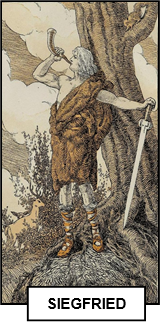 ”, replaced by a new “music drama” in which music flowed uninterrupted, the vocal line became “speech song” inspired by the text, and the whole production was woven into a total art work. This Gestamtkunstwerk, as he called it , was set up and developed by means of the leitmotifs, recurring themes by voice and orchestra (he called them "carriers of the feeling") which portrayed characters, emotions, ideas and events. In this new form, the power of his orchestration and the wide expressive range of his music, overthrowing as it did the traditional laws of harmony, gave birth to a new musical language in the Western World, and sent opera in a new and exciting direction. And his insistence that all great art must be based on mythology - Teutonic in his case - filled his works with a fervent nationalism at the very time when Germany was emerging as a great power on the European stage. By this fact alone he became to be seen not only as the undisputed master of German opera, but also as the heroic champion of the Germanic peoples.
”, replaced by a new “music drama” in which music flowed uninterrupted, the vocal line became “speech song” inspired by the text, and the whole production was woven into a total art work. This Gestamtkunstwerk, as he called it , was set up and developed by means of the leitmotifs, recurring themes by voice and orchestra (he called them "carriers of the feeling") which portrayed characters, emotions, ideas and events. In this new form, the power of his orchestration and the wide expressive range of his music, overthrowing as it did the traditional laws of harmony, gave birth to a new musical language in the Western World, and sent opera in a new and exciting direction. And his insistence that all great art must be based on mythology - Teutonic in his case - filled his works with a fervent nationalism at the very time when Germany was emerging as a great power on the European stage. By this fact alone he became to be seen not only as the undisputed master of German opera, but also as the heroic champion of the Germanic peoples.
xxxxxWagner, who wrote the librettos as well as the music for his operas, was a ruthless musical genius who possessed an overpowering belief in his own talent and a tenacious determination to achieve what he saw as his destiny: the creation of the “New Art Work of the Future”. Like the mythical Aryan heroes and demigods who crowded his operas, he was a larger-than-life character whose music aroused passions like no other composer before or since. Whilst he composed passages of rare majesty and beauty, his music-dramas, notably his later ones, are detested as much as they are admired. However, they cannot be ignored, and nor can anyone deny the immense accomplishment of their creator.
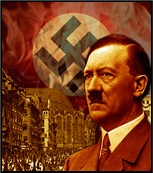
xxxxxWagner’s arrogance and conceit were compounded by his belief in the superiority of the German race and his utter disdain for the Jews. In a number of tracts written in the early 1850s - notably Judaism in Music and Opera and Drama - he wrote of the “harmful influence of Jewry on the morality of the nation”, and contended that the Aryans, having descended from the Gods, had been deprived of their godly status by inferior beings, such as the Jews. This idea of racial purity and the superiority of the German peoples formed the basis of Nazi ideology when the Nazis came to power in Germany in the 1930s. Their leader, Adolf Hitler, was known to be a great admirer of Wagner, his music and his philosophy.
xxxxxBut if Wagner’s influence was deferred in the field of politics, it was felt almost immediately in music and the arts in general. He had a profound influence on the compositions of Bruckner, Dvorak Mahler, Franck and Richard Strauss; Debussy and Schoenberg adopted aspects of his unique treatment; and his contemporaries Berlioz, Verdi and Brahms were admirers of his works even though they never quite understood them. On a wider front, the artists Degas, Whistler and Cézanne drew inspiration from his compositions, and many literary figures, notably Baudelaire and Mallarmé, made reference to Wagner in their writings.
xxxxxIncidentally, after Wagner’s death, the management of the Bayreuth Festival was taken over by his second wife Cosima (whom he married in 1870), and then by later descendants. Dedicated exclusively to the performance of Wagner’s operas, it is held each summer in northern Bavaria. ……
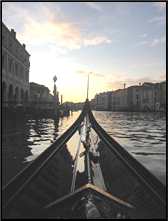
xxxxx……xxAs noted earlier, the 16th century Nuremberg meistersinger, poet and composer Hans Sachs, a cobbler by trade, is a major character in Wagner’s The Mastersingers of Nuremberg. ……
xxxxx……xxIn 1883 Franz Liszt (Wagner’s father-in-law) composed his piano solo La lugubre gondola to evoke the scene as a gondola, shrouded in black, crosses the Grand Canal in Venice, bearing Wagner’s body on the first stage of its journey to Bayreuth. ……
xxxxx……xxIronically, given Wagner’s anti-Semitism, it has now been fairly well established that Wagner was not the son of Carl Wagner, but the natural child of his mother’s lover (and second husband), a Jewish actor named Ludwig Geyer. ……
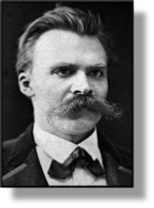
xxxxx…… For a number of years Wagner was a very close friend of the German philosopher Friedrich Nietzsche. They met at Leipzig in 1868, and Nietzsche visited him and Cosima when they were living at Tribschen. As we shall see, however, their friendship ended in the early 1880s, mainly due to Wagner’s anti-Semitism and his belief in the superiority of the German race. Ironically, despite Nitzsche’s dislike of such views, the Nazi party, making its own interpretation, used his writings to support and give credence to their own ideology. ……
xxxxx…… ThexGerman Hans von Bulow (1830-1894) was one of the most famous conductors of the second half of the 19th century, and the first to gain international recognition. He conducted the premiers of two of Wagner’s operas - Tristan and Isolde and The Mastersingers of Nuremberg - and promoted the works, among others, of Brahms, Tchaikovsky, Richard Strauss and Franck. He was also a virtuoso pianist and a composer in his own right.
Including:
Anton Bruckner and
Engelbert Humperdinck

Vb-1862-1880-Vb-1862-1880-Vb-1862-1880-Vb-1862-1880-Vb-1862-1880-Vb-1862-1880-Vb
xxxxxAs we have seen, it was in 1845 (Va) that the German composer Richard Wagner produced his opera Tannhauser. This, like his earlier work The Flying Dutchman and his Lohengrin of 1850, had little success. His ideas about opera went against the traditional form. In 1864, however, he received the support of the young king of Bavaria, Ludwig II, and was able to stage his dramatic love story Tristan and Isolde and his comic opera The Mastersingers of Nuremberg. Then in 1876 he performed his masterpiece The Ring of the Nibelung, in a purpose built opera house at Bayreuth in Bavaria. A monumental work made up of four operas, it was based, like much of his earlier work, on Germanic legend and myth. His final work was the opera Parsifal, a religious music-drama, premiered in 1882. Like the heroes and demigods in his operas, Wagner was a larger-than-life character who was determined to introduce a new musical language. His music-drama was a total art work (Gestamtkunstwerk), combining all the components - music, drama, poetry and scenic design - and developed by means of the leitmotifs, recurring themes which portrayed characters, emotions and ideas. His works gained him international renown. He became the undisputed master of German opera and, as an upholder of the Aryan race, a champion of the Germanic peoples.
xxxxxThe Austrian composer and organist Anton Bruckner (1824-1896) owed much of his success to Richard Wagner. He was organist at Linz Cathedral for twelve years and professor at the Vienna Conservatory for double that time, and during these periods he produced a wealth of choral pieces, both sacred and secular, as well as works for the organ and piano. In 1865, however, he met Wagner and became a great admirer and friend of the German composer. As a result, his nine symphonies, though influenced in part by Beethoven, took on his monumental style and heavy orchestration. Because of this, success came late, but his Seventh Symphony was well received in 1883, and in the last years of his life he was honoured throughout his homeland. As a virtuoso organist he played in Paris in 1869, and gave a number of recitals when visiting London in 1871. He was a humble, modest man but his innovative forms provided the link between the classical composers, like Beethoven, Haydn and Mozart, and the later Romantics such as Gustav Mahler (one of his pupils) and Arnold Schoenberg.
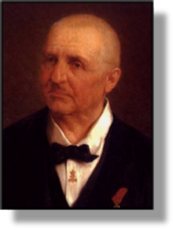 xxxxxThe Austrian composer and organist Anton Bruckner (1824-1896) owed much of his success to Richard Wagner. Born at Ansfelden, near Linz, and trained as a school teacher, he learnt to play the organ while a choirboy at the nearby Augustan monastery of St. Florian. He began his musical career with a requiem mass in 1849, and was appointed organist at Linz Cathedral six years later. There he composed a wealth of church music, including three Masses.
xxxxxThe Austrian composer and organist Anton Bruckner (1824-1896) owed much of his success to Richard Wagner. Born at Ansfelden, near Linz, and trained as a school teacher, he learnt to play the organ while a choirboy at the nearby Augustan monastery of St. Florian. He began his musical career with a requiem mass in 1849, and was appointed organist at Linz Cathedral six years later. There he composed a wealth of church music, including three Masses.
xxxxxIn 1865, however, after meeting Wagner at the first night of Tristan and Isolde, his career took a new and stormy direction. He became a great admirer and friend of the German composer, and, whilst influenced by the richly romantic harmony associated with Beethoven, he took to writing in his monumental style, producing symphonies noted for their epic proportions and heavy orchestration. He is best remembered today for his Seventh Symphony of 1883, a work in which the deeply mournful slow movement was written to commemorate the death of Wagner.
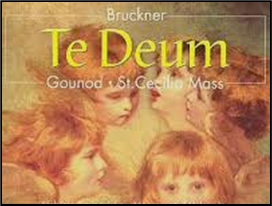 xxxxxHe became professor and court organist at the Vienna Conservatoire in 1868, a post he held until 1892, and it was during that time that he composed eight symphonies as well as producing many choral pieces and works for the organ and piano. During his career he contributed to the development of the sonata, and often composed passages of unorthodox structure. Success was slow in coming, due in the main to what some regarded as his wild and nonsensical Wagnerian style. However, in the last years of his life he was honoured throughout his homeland, granted a government pension, and awarded the Order of Franz Joseph and an honorary doctorate from the University of Vienna. Among his many other works two deserve special mention, his Te Deum in C for soloists, chorus and orchestra, completed in 1884, and his beautiful String Quintet of 1889.
xxxxxHe became professor and court organist at the Vienna Conservatoire in 1868, a post he held until 1892, and it was during that time that he composed eight symphonies as well as producing many choral pieces and works for the organ and piano. During his career he contributed to the development of the sonata, and often composed passages of unorthodox structure. Success was slow in coming, due in the main to what some regarded as his wild and nonsensical Wagnerian style. However, in the last years of his life he was honoured throughout his homeland, granted a government pension, and awarded the Order of Franz Joseph and an honorary doctorate from the University of Vienna. Among his many other works two deserve special mention, his Te Deum in C for soloists, chorus and orchestra, completed in 1884, and his beautiful String Quintet of 1889.
xxxxxAs a virtuoso organist he was well received in Paris in 1869, and, during a visit to London in 1871, he gave six recitals at the Royal Albert Hall and five more at the Crystal Palace. And towards the end of his career he toured various German towns to hear performances of his works. He was a modest man of humble birth, but by his innovative forms - particularly in his symphonies - he made the link between the classical heritage of composers like Beethoven, Haydn and Mozart, and the later Austrian Romantics such as Gustav Mahler (one of his valued pupils) and Arnold Schoenberg.
xxxxxIncidentally, the constant criticism levelled at his symphonies unnerved Bruckner and, as a result, he tended to revise his works a number of times. However, he bequeathed his original manuscripts to the Vienna National Library, and it is upon these that his symphonies are now based.
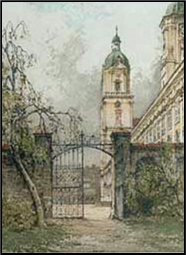
xxxxx…… A deeply religious man, the monastery of St. Florian, where he studied and taught as a young man, remained a place of spiritual refuge for him throughout his life. In accordance with his wishes, when he died in 1896 he was buried in the monastery’s crypt, directly under the organ . ……
xxxxx…… As with Wagner, the Nazis approved of Bruckner’s music, and in 1937 the Nazi leader, Adolf Hitler, unveiled a bust of the composer. And in May 1945, when Hitler’s death was broadcast to the German people, the announcement was accompanied by the Adagio from his 7th Symphony.
xxxxxThe German composer Engelbert Humperdinck (1854-1921) was a great admirer of Richard Wagner. He met him in Naples in 1879, and assisted him in the production of Parsifal in the early 1880s. Today he is remembered for his production of the children’s story Hansel and Gretel. He weaved the fairy tale around simple German folk songs, but employed Wagnerian orchestration and techniques to develop the story and heighten the musical interest. The premier, conducted by Richard Strauss at Weimar in December 1893, was a huge success. Humperdinck wrote other operas as well as songs, piano pieces and incidental music for a number of plays, but his reputation rests almost exclusively upon his production of Hansel and Gretel.
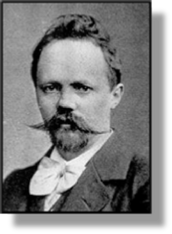
xxxxxAnd another musician who became a disciple of Richard Wagner was Engelbert Humperdinck, (1854-1921), the composer of the delightful children’s story Hansel and Gretel. He was born at Siegburg, near Hanover, and showed musical talent at an early age. After studying music at Cologne and Munich, he was the first to win the Mendelssohn scholarship (awarded by the Mendelssohn foundation in Berlin), and this enabled him to travel to Italy in 1879. It was there, while in Naples, that he met Wagner, became inspired by his ideas, and was invited to Bayreuth to assist in the production of the opera Parsifal.
xxxxxAfter working at the Festival Theatre in the early 1880s, where he studied under Wagner, he resumed his travels, and over the next ten years taught at the Barcelona Conservatory and the Hoch Conservatory in Frankfurt. It was in 1891, while in Frankfurt, that he began 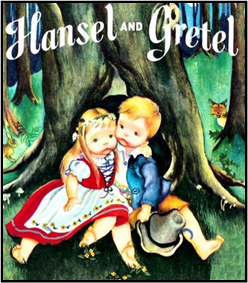 writing Hansel and Gretel, a folk story told by the Grimm Brothers. It started out as a play with songs and piano accompaniment, - requested by his sister Adelheid to entertain her children - but he soon realised the story’s potential and turned it into a full-scale opera. He weaved the story around simple German folk songs, but he employed Wagnerian orchestration and techniques, making particular use of leitmotifs, recurring themes to develop the story and heighten the musical interest. The premier, conducted by Richard Strauss at Weimar in December 1893, was a huge success.
writing Hansel and Gretel, a folk story told by the Grimm Brothers. It started out as a play with songs and piano accompaniment, - requested by his sister Adelheid to entertain her children - but he soon realised the story’s potential and turned it into a full-scale opera. He weaved the story around simple German folk songs, but he employed Wagnerian orchestration and techniques, making particular use of leitmotifs, recurring themes to develop the story and heighten the musical interest. The premier, conducted by Richard Strauss at Weimar in December 1893, was a huge success.
xxxxxFollowing this triumph Humperdinck wrote a number of works for the stage - including The Reluctant Marriage (1905), The Christmas Dream (1906), and The King’s Children (1910) - but none had the same impact. Indeed, today his reputation rests almost exclusively upon his production of Hansel and Gretel. During his career he also composed songs and works for the piano, and he wrote incidental music for a number of plays, including four of Shakespeare’s works.
xxxxxIncidentally, Wagner thought so highly of Humperdinck’s ability that he appointed him music tutor to his son Siegfried. ……
xxxxx…… In the production of his opera The King’s Children, produced in 1910, Humperdinck was the first composer to introduce Sprechgesang, a vocal technique which was half way between singing and speaking. ……
xxxxx…… In 1923 Hansel and Gretel became the first complete opera ever to be broadcast on the radio, transmitted from Covent Garden in London.






 xxxxxAs we have seen, it was in 1845 (Va) that the German composer Richard Wagner produced his opera Tannhauser. This, together with his earlier work The Flying Dutchman (1843) and his later work Lohengrin (1850), had little success. His novel idea that opera should be a total blend of all its components -
xxxxxAs we have seen, it was in 1845 (Va) that the German composer Richard Wagner produced his opera Tannhauser. This, together with his earlier work The Flying Dutchman (1843) and his later work Lohengrin (1850), had little success. His novel idea that opera should be a total blend of all its components - xxxxxBut in 1864 fate took a hand and made possible the fulfilment of his destiny. In that year the young Ludwig II came to the throne of Bavaria. A fanatical devotee of Wagner, he invited him to Munich, paid off his debts, provided him with a villa and a generous allowance, and put the city’s opera house at his disposal. At last, living in the comfort for which he yearned, he was able to let the world hear and enjoy his revolutionary works. Tristan and Isolde was given its premier the next year, a passionate story of forbidden love, inspired at the time of its composition (the late 1850s) by his own unfulfilled dreams of love for Mathilde Wesendonck, the wife of one of his patrons. In this work he was influenced by the writings of the German philosopher Arthur Schopenauer. In accordance with his contention that music was more important than the word, he gave the orchestra the predominant role in the drama, filling the stage with a rich outpouring of sound and passion, rapture and gloom. In fact it took some time for the opera to be widely performed, mainly because of its length, unfamiliar style, and the difficulty of finding singers capable of coping with the two major roles.
xxxxxBut in 1864 fate took a hand and made possible the fulfilment of his destiny. In that year the young Ludwig II came to the throne of Bavaria. A fanatical devotee of Wagner, he invited him to Munich, paid off his debts, provided him with a villa and a generous allowance, and put the city’s opera house at his disposal. At last, living in the comfort for which he yearned, he was able to let the world hear and enjoy his revolutionary works. Tristan and Isolde was given its premier the next year, a passionate story of forbidden love, inspired at the time of its composition (the late 1850s) by his own unfulfilled dreams of love for Mathilde Wesendonck, the wife of one of his patrons. In this work he was influenced by the writings of the German philosopher Arthur Schopenauer. In accordance with his contention that music was more important than the word, he gave the orchestra the predominant role in the drama, filling the stage with a rich outpouring of sound and passion, rapture and gloom. In fact it took some time for the opera to be widely performed, mainly because of its length, unfamiliar style, and the difficulty of finding singers capable of coping with the two major roles.  xxxxxBut still to come was his masterpiece The Ring of the Nibelung, a sequence of four operas based on Teutonic myth and legend, and having as its theme -
xxxxxBut still to come was his masterpiece The Ring of the Nibelung, a sequence of four operas based on Teutonic myth and legend, and having as its theme - xxxxxThe following year, after conducting in London, he began work on his final opera Parsifal, a religious music-
xxxxxThe following year, after conducting in London, he began work on his final opera Parsifal, a religious music- ”, replaced by a new “music drama” in which music flowed uninterrupted, the vocal line became “speech song” inspired by the text, and the whole production was woven into a total art work. This Gestamtkunstwerk, as he called it , was set up and developed by means of the leitmotifs, recurring themes by voice and orchestra (he called them "carriers of the feeling") which portrayed characters, emotions, ideas and events. In this new form, the power of his orchestration and the wide expressive range of his music, overthrowing as it did the traditional laws of harmony, gave birth to a new musical language in the Western World, and sent opera in a new and exciting direction. And his insistence that all great art must be based on mythology -
”, replaced by a new “music drama” in which music flowed uninterrupted, the vocal line became “speech song” inspired by the text, and the whole production was woven into a total art work. This Gestamtkunstwerk, as he called it , was set up and developed by means of the leitmotifs, recurring themes by voice and orchestra (he called them "carriers of the feeling") which portrayed characters, emotions, ideas and events. In this new form, the power of his orchestration and the wide expressive range of his music, overthrowing as it did the traditional laws of harmony, gave birth to a new musical language in the Western World, and sent opera in a new and exciting direction. And his insistence that all great art must be based on mythology -



 xxxxxThe Austrian composer and organist Anton Bruckner (1824-
xxxxxThe Austrian composer and organist Anton Bruckner (1824- xxxxxHe became professor and court organist at the Vienna Conservatoire in 1868, a post he held until 1892, and it was during that time that he composed eight symphonies as well as producing many choral pieces and works for the organ and piano. During his career he contributed to the development of the sonata, and often composed passages of unorthodox structure. Success was slow in coming, due in the main to what some regarded as his wild and nonsensical Wagnerian style. However, in the last years of his life he was honoured throughout his homeland, granted a government pension, and awarded the Order of Franz Joseph and an honorary doctorate from the University of Vienna. Among his many other works two deserve special mention, his Te Deum in C for soloists, chorus and orchestra, completed in 1884, and his beautiful String Quintet of 1889.
xxxxxHe became professor and court organist at the Vienna Conservatoire in 1868, a post he held until 1892, and it was during that time that he composed eight symphonies as well as producing many choral pieces and works for the organ and piano. During his career he contributed to the development of the sonata, and often composed passages of unorthodox structure. Success was slow in coming, due in the main to what some regarded as his wild and nonsensical Wagnerian style. However, in the last years of his life he was honoured throughout his homeland, granted a government pension, and awarded the Order of Franz Joseph and an honorary doctorate from the University of Vienna. Among his many other works two deserve special mention, his Te Deum in C for soloists, chorus and orchestra, completed in 1884, and his beautiful String Quintet of 1889.

 writing Hansel and Gretel, a folk story told by the Grimm Brothers. It started out as a play with songs and piano accompaniment, -
writing Hansel and Gretel, a folk story told by the Grimm Brothers. It started out as a play with songs and piano accompaniment, -

